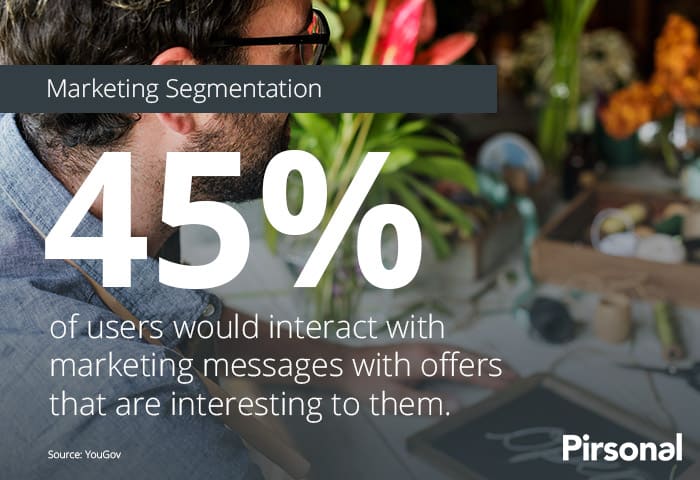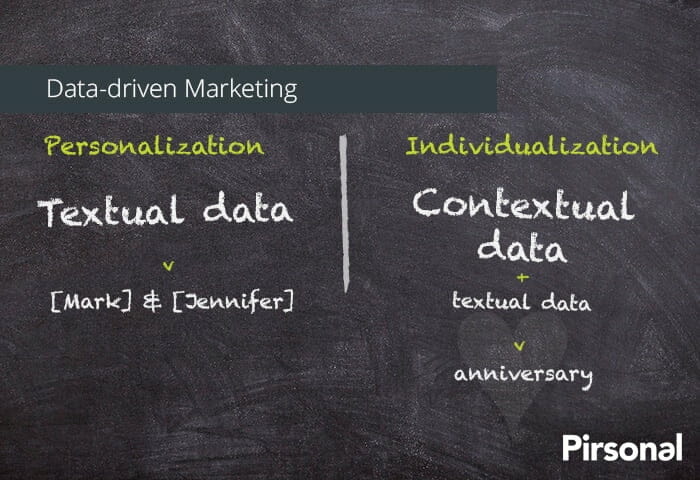A buyer persona is a key part of any personalized video marketing strategy. The most effective personalized marketing programs are based on what you know about real people to achieve a higher grade of effectiveness. Even more, great personalized marketing initiatives use customer data as a pillar to enrich every message and content. This data is the door for the best programs to create a personalized message for an individual based on his augmented buyer persona (ABP), a marketing term we use internally at Pirsonal to create personalized marketing strategies, especially with multimedia content.

Buyer personas help you improve your product’s or service’s value proposition, increase profits and create higher lead conversions. By using them, you can create the best marketing messages and plan your distribution aligned to your target’s interests based on what you know about other people that have a similar background.
Watch the following video to understand the key concept behind an augmented buyer persona and personalized marketing:
DemandGen reported that Thomson Reuter saw a 175% increase in revenue attributed to the use of marketing buyer personas and a 72% reduction in lead conversion time. Here you have an article where I explain why defining your buyer personas is a vital part of any personalized video strategy.
And here you have a great infographic by SingleGrain that shows how to easily create a buyer persona. But, is creating a buyer persona enough? Please keep reading to understand why a buyer persona is not enough.
When A Buyer Persona Is Not Enough
Let’s be honest, sometimes using customer data is not enough. Creating a buyer persona is only one of the steps to create personalized marketing content that will make your customers and leads react and you get better marketing conversions. To understand when and why a buyer persona falls short, we need to go back to the buyer persona definition. As a reminder, a buyer persona is a fictional character created to represent a user type that might use your product or service but also is the person that will consume your marketing messages. Buyer personas are a fictionalized characterization of your best customer based on information about them.
This means that a buyer persona is mostly based on other people but not precisely on the individual you are targeting with marketing communications or for whom you have created a product. From an operations perspective, buyer personas are less flexible when thinking about products and services but can be really flexible when thinking about digital marketing.

Basing our marketing messages solely on buyer personas limits your game and the potential of your strategy. Let’s see why…
What’s the difference between “John 1” that just signed a car leasing contract and “John 2” that just did the same? Advertisers, copywriters, and marketers will usually create the same type of message for each one of them based on what they know about previous buyers with a similar profile, which makes sense.
There must be more than just a name, don’t you think? Ok, one can think about the car brand or even the car model (BTW, check this case study about a car brand using video marketing automation to increase customer engagement). That would be a great first step but I’m sure we can do a bit better, which will lead us to the augmented buyer persona.
The purpose of this article is to dive deep into what an augmented buyer persona is. This will help you create better personalized videos and other types of personalized marketing content, from personalized emails to personalized calls to action and more.
What Is An Augmented Buyer Persona?
I’m sure there is already a marketing term for this. This is just the way I call a buyer persona on vitamins.
Creating buyer personas is a common practice that helps you materialize how your customers might be based on your experience with other customers with similar characteristics, which is a lot better than your best guess or a marketing briefing talking about the target audience.
Please, don’t take me wrong. Sometimes all you have is your best guess and a report on your target audience for a campaign is a must if you have this information. But there is more to that, especially when you see that the different communication channels are increasingly saturated and we are in the battle of engagement.
Let’s see this with a simple example.
John is a 50 years old car driver that wants a Mercedes-Benz. John has a steady income, an executive position, is married and still has children under his roof. He doesn’t have time to take care of his car and at this stage of life; he wants to enjoy new emotions and share them with other peers.
John meets the average profile of a car leasing customer. When he signs the contract, this is the available marketing data John provides:
- Name
- Car model
- Car brand
- Leasing months
- Monthly fee
- Included services
- After-contract options
- Miles/Kilometers per year
- Insurance
- Lifestyle interests
The Customer Experience Department probably knows more about him. In the end, we are talking about a financial service company, so they may know his household income, how he initially found out about the service, his grade of interest thanks to some e-mail marketing metrics and even the time spent on their website. They probably know the number of people that live with him and maybe the type of insurance they all have. That’s a lot of information that in most cases will be distributed across different software or even spreadsheets.

If we stick to a buyer persona, we would still be thinking about John, the 50 years old driver that wants a Mercedes-Benz and has no time to take care of his car. But there is a lot more behind the data John has shared with the CX department in one or another way. John’s general profile is helpful to create a general message or its frame, choose the right channel and even suggest what product is a good fit for him. However, as I mentioned above, as customers, we are saturated with marketing messages and companies are forced to be relevant to their customers, individually.
Most CX teams will stay just there, in the average profile based on a buyer persona. But if you are reading this, I’m sure you can do better whenever it’s possible.
Nevertheless, when you use the information John has provided in “real-time” to create contextualized marketing messages on vitamins, you are creating and using what I call an augmented buyer persona. An augmented buyer persona goes one step further than a buyer persona.
An augmented buyer persona is the profile of an individual comprised by all the interrelated information gathered about that individual provided by one or many data sources and the individual’s buyer persona, taking into consideration the individual’s particular context to create products, services and, most commonly, marketing messages that fit the individual’s needs, objections, desires, and interests, aligned with the objectives set by the organization.
This is, a customer profile not only based on what you thought you knew about people similar to John but especially what you know about him based on the marketing data your customer or lead has provided through one or several marketing channels. This information is used to create textual and especially contextual messages that support your personalized marketing and help your customers engage with your message in a deep way, which will help you get the type of marketing conversions you need.
The buyer persona is required to design the general marketing collateral, assets, and more, and the augmented buyer persona is used to create specific messages and media assets depending on the specific characteristics of a person thanks to all the interrelated and gathered information about that individual. It can also be used to redefine other areas like the distribution channel, campaign schedules or product offers (upselling, cross-selling, etc.).

Marketing segmentation is a crucial part of this personalization strategy. Although this technique is more obvious when creating the best personalized videos, it should be used in any message related not only to customized videos, but to any message addressed to the client, from personalized emails to personalized landing pages.
Remember, modern marketing should always be a conversation and there is no better way to participate in a conversation than using the other person’s context so that your messaging resonates with this person’s needs, desires, objections, and expectations. This is what 1:1 marketing is about.
How To Create An Augmented Buyer Persona
Back to John, you can use textual information to get his attention and contextual information to make the message directly resonate with his context and increase the chances for a higher conversion rate. The way to do this is to ask yourself what “car model”, “car brand”, “leasing months”, “lifestyle interest”… means for John and how this context is related to any other piece of information you know about him.
John already knows the car model he has chosen but, what does this mean when thinking about the lifestyle interests he has shared with you? John already knows how much money he’ll be paying for his new Mercedes-Benz but, how the amount of money he’ll be paying month after month is related to the fact that he has teenagers under his roof and he is 5o years old?
Using your customer’s or lead’s augmented buyer persona to create better contextualized and personalized marketing messages will take more time to brainstorm and decide what all the variables and structured data have to tell you about each individual but at the same time will help you create solid personalized videos that talk to the individual. Download this checklist to know how to create a robust personalized video marketing strategy from scratch.
With this in mind, in this video I show how to create personalized emails that get better conversions using this augmented buyer persona approach.
The Bottom Line
When you use the augmented buyer persona approach, the characteristics of the person you initially thought you were targeting change. This should also make you adapt and customized your marketing messages according to this person’s context.

It is a metamorphosis or as if that individual would now remove a mask, allowing you to know more about particular interests, objections, goals, desires, based on the interrelated data you have gathered. What initially was a fictional character powered by a buyer persona, becomes a real person whom you can have a conversation with.
Remember, marketing is about a conversation and customer experience must be based on what you know about that customer to then create an empowering and relevant experience.

